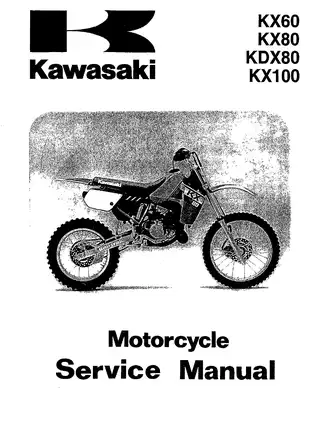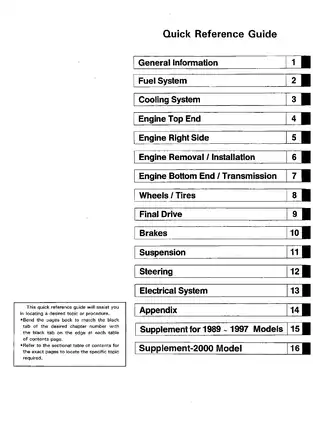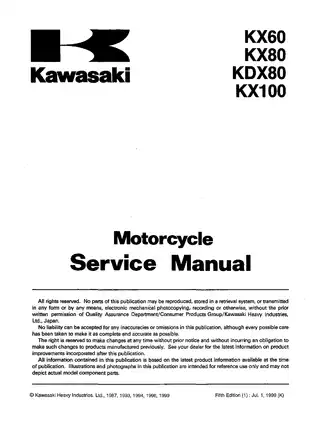Kawasaki KX60, KX80, KDX80, KX100 : Precision Maintenance & Repair (1989-1997)
Product Gallery

Sample pages from the Kawasaki KX60, KX80, KDX80, KX100 : Precision Maintenance & Repair (1989-1997) manual



Purchase Information
1989-1997 Kawasaki Motorcycle Service Manual: KX60, KX80, KDX80, KX100 - Technical Specifications
- Document Number / Seller:
- 31095 / Thomas Martin
- File Size:
- 10.21 MB
- File Type:
- Language:
- English (some of our manuals are multilingual)
- Printable:
- Yes
- Estimated Download Time:
- 0.21 Minutes
- Delivery Format:
- Digital (PDF) - Instant Access
- Category:
- Motorcycle
- Brand:
- Kawasaki
Kawasaki Models and Parts Covered in this Motorcycle Manual
- KX60 (1989-1997)
- KX80 (1989-1997)
- KDX80 (1989-1997)
- KX100 (1989-1997)
Complete Manual Information
Kawasaki Motorcycle Service Manual for Models KX60, KX80, KDX80 and KX100 (1989-1997)
Ensure your Kawasaki motorcycle remains in peak condition with our comprehensive service manual, covering detailed maintenance and repair procedures for the KX60, KX80, and KDX80 models produced between 1989 and 1997. This manual is an invaluable resource, whether you're a professional mechanic or an avid DIY enthusiast.
Key Features:
- Comprehensive Coverage: Detailed guidance on maintenance protocols for all major systems including the engine, fuel, drive chain, and suspension components.
- User-Friendly Interface: Navigate through the manual with ease, thanks to organized sections and clear headings.
- Effective Troubleshooting: Identify and fix common issues with step-by-step instructions.
- Visual Aids: Numerous diagrams and illustrations illustrating vital processes such as component disassembly and assembly.
What's Inside
Our manual includes meticulous breakdowns of:
- General Information: Overview of the motorcycle systems, specifications, and model identification.
- Engine Components: Instructions for maintenance of the engine including removal, servicing, and parts specifications.
- Fuel System: Comprehensive guide on carburetor maintenance, fuel level inspections, and adjustments.
- Brake System: Detailed procedures for brake lever adjustments, fluid change, and inspection.
- Suspension: Maintenance tips for front forks and rear shock absorbers, including adjustments and oil levels.
- Drive Chain & Sprockets: Insights on chain slack adjustments, wear inspections, and replacement procedures.
Table of Contents:
- Exploded Views of All Components
- Transmission and Engine Removal/Installation Instructions
- Brake and Suspension Adjustments
- Common Troubleshooting Tips
- Maintenance Schedules
Additional Information:
- Compatible Models: This manual is designed specifically for Kawasaki models KX60, KX80, and KDX80, manufactured between 1989 and 1997.
- Practical Maintenance Resource: With expert advice combined with illustrative diagrams, you can maintain your motorcycle in peak performance without expensive mechanic fees.
Invest in the comprehensive KX60/KX80/KDX80 Kawasaki Motorcycle Service Manual today and keep your vehicle performing at its best!
Download Instructions for Kawasaki Motorcycle Manual
Frequently Asked Questions - Kawasaki Motorcycle Manual
What does this Kawasaki manual cover?
This comprehensive service manual covers detailed repair procedures, maintenance schedules, troubleshooting guides, and technical specifications for Kawasaki KX60, KX80, KDX80, KX100 : Precision Maintenance & Repair (1989-1997). It includes information for the following models: - KX60 (1989-1997) - KX80 (1989-1997) - KDX80 (1989-1997) - KX100 (1989-1997).
Is this manual suitable for beginners?
Yes, this Kawasaki manual is designed for both professional technicians and DIY enthusiasts. It includes step-by-step procedures with clear illustrations and safety guidelines for Motorcycle maintenance and repair.
What file format will I receive?
You will receive this manual as a PDF file (10.21 MB), which is compatible with all devices. The manual is fully searchable and printable for your convenience.
How quickly can I access the manual after purchase?
You'll receive instant access to your Kawasaki Motorcycle manual immediately after payment completion. The download link is valid for 3 days, with lifetime re-download guarantee.
Are engine specifications included?
This motorcycle service manual includes detailed engine specifications, valve clearances, torque settings, and performance data specific to your Kawasaki model.
Can I print specific sections of the manual?
Absolutely! This digital manual allows you to print any section you need, from individual pages to complete chapters, making it perfect for workshop use.
Customer Reviews and Feedback
Read what our customers say about this Kawasaki Motorcycle manual and share your own experience.
Add Comment
This policy contains information about your privacy. By posting, you are declaring that you understand this policy:
- Your name, rating, website address, town, country, state and comment will be publicly displayed if entered.
- Aside from the data entered into these form fields, other stored data about your comment will include:
- Your IP address (not displayed)
- The time/date of your submission (displayed)
- Your email address will not be shared. It is collected for only two reasons:
- Administrative purposes, should a need to contact you arise.
- To inform you of new comments, should you subscribe to receive notifications.
- A cookie may be set on your computer. This is used to remember your inputs. It will expire by itself.
This policy is subject to change at any time and without notice.
These terms and conditions contain rules about posting comments. By submitting a comment, you are declaring that you agree with these rules:
- Although the administrator will attempt to moderate comments, it is impossible for every comment to have been moderated at any given time.
- You acknowledge that all comments express the views and opinions of the original author and not those of the administrator.
- You agree not to post any material which is knowingly false, obscene, hateful, threatening, harassing or invasive of a person's privacy.
- The administrator has the right to edit, move or remove any comment for any reason and without notice.
Failure to comply with these rules may result in being banned from submitting further comments.
These terms and conditions are subject to change at any time and without notice.
Comments (4)